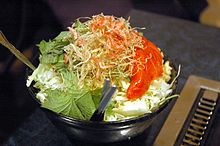Monjayaki
This article may require copy editing for grammar, style, cohesion, tone, or spelling. (January 2016) |


Monjayaki (もんじゃ焼き) (often called simply "monja") is a type of Japanese pan-fried batter, popular in the Kantō region, similar to the related dish okonomiyaki, but different in that different liquid ingredients are used while cooking.
Description
The ingredients in Monjayaki are finely chopped and mixed into the batter before frying. Monjayaki batter has ingredients similar to okonomiyaki. The difference between the two dishes is the additional dashi or water added to the monjayaki batter mixture, making it runnier than okonomiyaki. The consistency of cooked Monjayaki is comparable to a pool of melted cheese.
Monjayaki also differs from okonomiyaki because the diners eat it directly off the iron grill using a small spatula.[1] Monjayaki diners also participate in the cooking by spreading raw monja on the grill so that crispy bits form and caramelize. Many monjayaki restaurants can be found in the Tsukishima district of Tokyo where the dish is said to have originated. Most of these restaurants also serve regular okonomiyaki.[2]
See also
References
- ^ "Diner's dilemma: Okonomiyaki or monjayaki? | CNN Travel". travel.cnn.com. Retrieved 2016-02-13.
- ^ Trautlein, Steve, "The chow-down tour of Kanto's local dishes", The Japan Times, 24 August 2012, p. 15.
